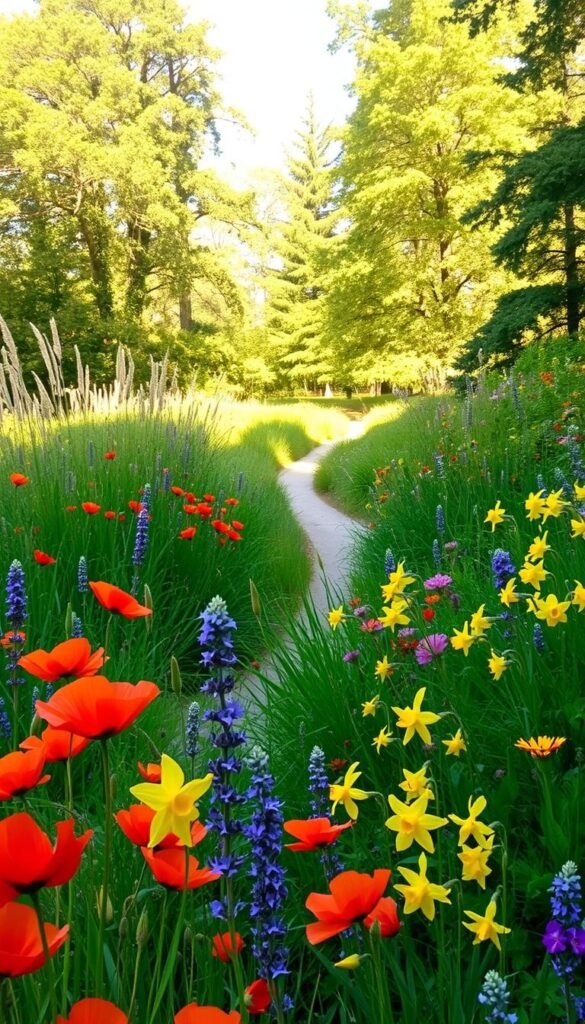Imagine transforming your open property into a vibrant ecosystem that celebrates natural beauty. Large outdoor areas provide the perfect canvas to craft a living tapestry of colors and textures, blending human creativity with ecological balance.
By embracing low-maintenance design principles, you can create a thriving habitat that evolves organically. Native blooms and grasses adapt to local conditions, forming resilient plant communities that require less watering and upkeep over time.
This approach celebrates seasonal shifts, offering ever-changing views while supporting pollinators and local wildlife. Strategic pathways and viewing areas let you enjoy the scenery without disrupting delicate ecosystems. You’ll discover how subtle interventions can guide growth while preserving nature’s spontaneity.
Your landscape becomes more than decoration – it’s a sanctuary where biodiversity flourishes. Through smart plant selection and thoughtful layout, you’ll create visual harmony that feels both intentional and effortlessly wild. The result? A dynamic outdoor environment that saves time, resources, and energy while boosting ecological health.
Planning Your Wildflower Garden Layout for Large Spaces
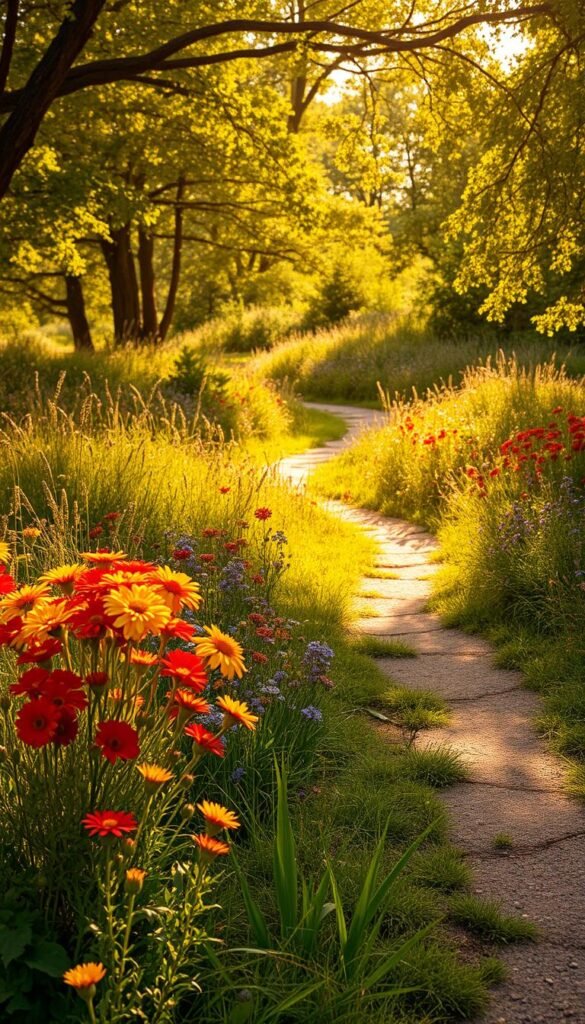
Creating a flourishing outdoor haven begins with smart spatial planning. Start by mapping your property’s unique features – slopes, flat zones, and existing plants – to work with the land rather than against it.
Assessing Your Outdoor Area and Available Space
Walk your property during different daylight hours. Note sunny spots where coneflowers thrive and shaded areas perfect for columbines. Mark zones where water collects naturally – these spots might need drainage adjustments.
Consider creating a meadow-like centerpiece if you have open space. Use native grasses as anchors, then add colorful blooms in clusters. Leave some edges untamed to blend with surrounding nature.
Designing Natural Pathways and Plant Zones
Curving trails invite exploration while protecting delicate plants. Try these materials for functional charm:
| Material | Cost | Maintenance | Best For |
|---|---|---|---|
| Wood chips | $ | Annual refresh | Shady zones |
| Crushed gravel | $$ | Weed control | Sunny routes |
| Stepping stones | $$$ | Occasional leveling | Wet areas |
Add seating nooks where paths intersect. These resting spots let you enjoy seasonal changes – from spring’s first blooms to autumn’s golden grasses. Keep main trails clear even when plants reach full height for year-round access.
Understanding Soil and pH Requirements for a Thriving Garden
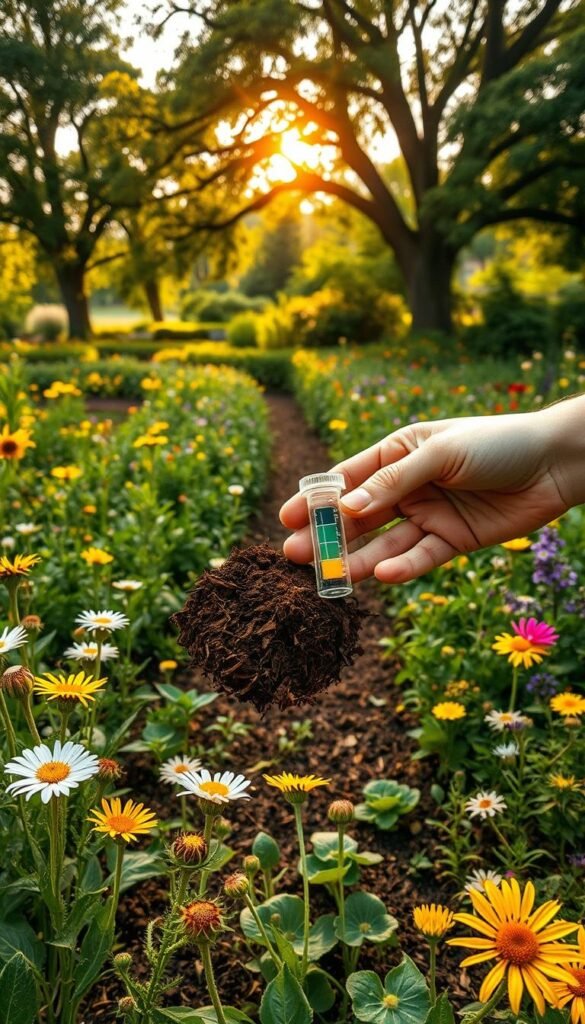
What’s the secret to a thriving wildflower meadow? It starts beneath your feet. The right soil conditions determine whether your plants struggle or flourish. Think of earth as a living pantry – its pH balance decides which nutrients become available to roots.
Identifying Acidic, Neutral, and Alkaline Soils
Grab a soil test kit from your local nursery – it’s simpler than baking cookies. Results show where your land falls on the 0-14 pH scale. Numbers below 7 mean acidic soil (common in rainy regions), while above 7 indicates alkaline earth (typical in arid zones).
Don’t assume uniform conditions across your space. Test multiple areas – that sunny slope might differ from shaded low spots. Most native species adapt well to slightly acidic or neutral ranges (6.0-7.5). Work with what you have rather than fighting chemistry.
Improving Soil with Organic Matter and Compost
Your soil’s best friend? Decomposed compost. Mix in 2-3 inches annually to:
- Balance pH naturally
- Boost water retention
- Create air pockets for roots
Aged manure or leaf mold works wonders too. These amendments feed earthworms and microbes that sustain plant health. For large areas, focus on trouble spots rather than blanketing the entire space. Remember – healthy soil grows resilient plants that need less care over time.
Skip drastic pH changes with chemicals unless dealing with extreme values (below 5.5 or above 8.5). Annual spring tests help track improvements and guide your composting efforts. Keep notes – you’ll spot patterns that make future planning easier.
Choosing Native Wildflowers and Perennials for Sustainable Impact
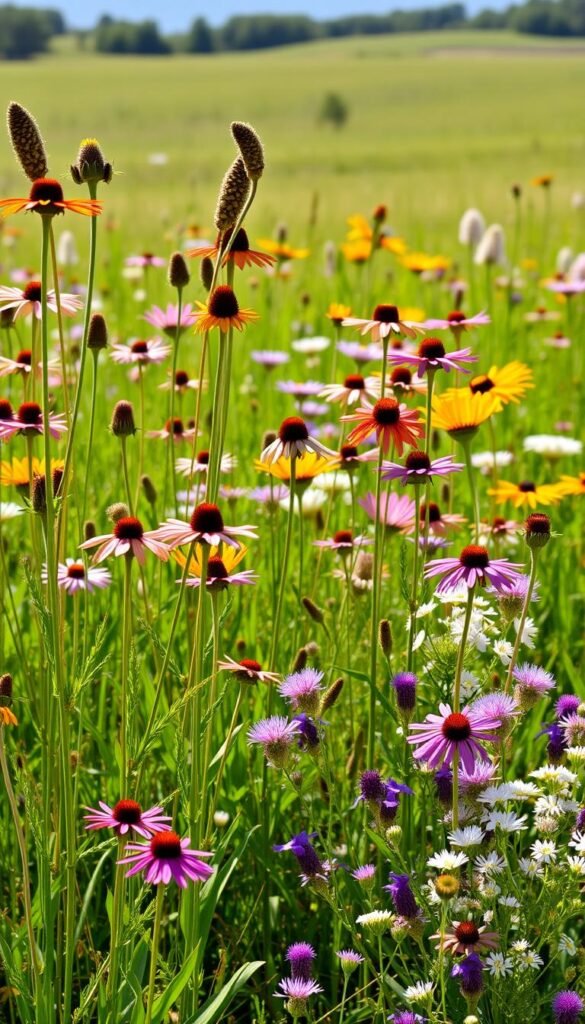
Your landscape becomes a living legacy when you partner with regional flora. Local native plants offer built-in resilience, creating ecosystems that maintain themselves while supporting local wildlife.
Selecting Drought-Tolerant Native Species
Deep-rooted species like butterfly weed and prairie clover thrive where others wither. These champions evolved to handle your area’s rainfall patterns, needing minimal watering after establishment. Consider these regional favorites:
| Plant | Water Needs | Pollinator Appeal |
|---|---|---|
| Blazing Star | Low | Butterfly magnet |
| Penstemon | Very low | Hummingbird favorite |
| Yarrow | None | Beneficial insect host |
Seasonal Considerations for Wildflower Varieties
Plan for year-round interest with strategic bloom times. Early risers like Virginia bluebells kickstart spring, while autumn’s New England asters provide late-season nectar. Try this progression:
- Spring: Foxglove beardtongue
- Summer: Purple prairie clover
- Fall: Switchgrass accents
Many native plants self-seed naturally, filling gaps without extra work. Always verify seed sources – reputable suppliers guarantee regional adaptability and invasive-free mixes. Your choices today shape tomorrow’s thriving habitat.
Optimizing Sunlight and Watering Needs for Your Wildflower Beds
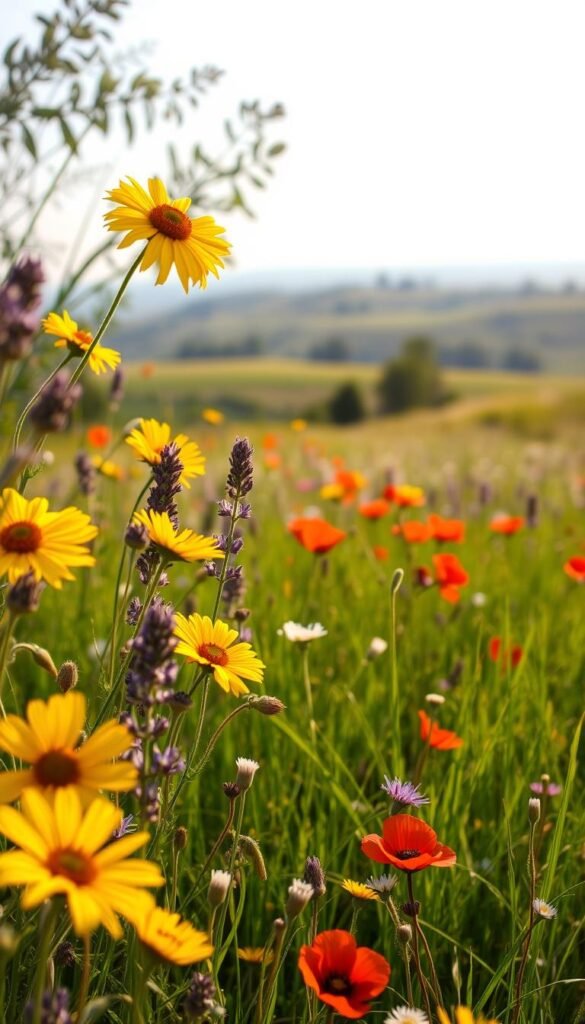
Sunlight and water form the heartbeat of every thriving meadow. Getting this balance right helps your plants enjoy their environment while reducing maintenance time. Start by understanding your space’s unique patterns – nature’s rhythm guides growth more effectively than rigid schedules.
Evaluating Direct Sunlight Requirements
Track how shadows move across your space through seasons. Full-sun varieties need six+ hours of direct light – ideal for open areas. Partial-sun species thrive with morning exposure and afternoon shade. Watch for these sunlight stealers:
- Leafy tree canopies in summer
- Tall structures casting long shadows
- Slopes changing sun angles
Watering Techniques for Diverse Climates
New seedlings crave consistent moisture. Use these strategies during critical first weeks:
- Morning watering reduces evaporation
- Drip systems target roots without waste
- Mulch preserves soil dampness
In arid regions, water every 2-3 days after establishment. Humid climates? Let rainfall handle hydration. Always check soil moisture 2 inches deep before adding water.
Healthy roots develop when you gradually reduce watering frequency. This approach strengthens plants while supporting local ecosystems. Remember: Overwatering harms more than drought – it invites mold and weak stems.
Cultivating Biodiversity: Attracting Bees, Birds, and Insects
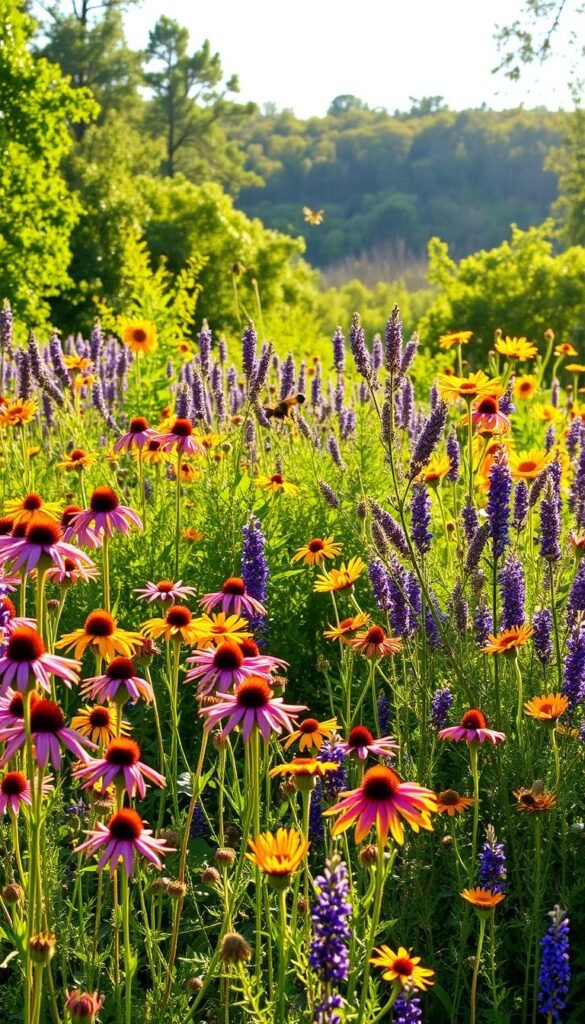
Your outdoor space can become a lively sanctuary where winged visitors thrive. By designing with purpose, you’ll support essential wildlife while enjoying nature’s daily performances.
Enhancing Your Space with Pollinator-Friendly Plants
Bright blooms act as nature’s welcome signs. Bees flock to yellow coneflowers, while hummingbirds dart toward scarlet bee balm. Mix native species with varying bloom times to keep food available from spring thaw to first frost.
Try these seasonal crowd-pleasers:
- Early spring: Golden Alexander (bees’ first meal)
- Summer: Purple milkweed (butterfly favorite)
- Fall: New England aster (late-season nectar)
Leave some areas undisturbed – leaf piles and dead stems shelter insects through winter. Birds follow the buffet, snacking on seeds and bugs. Pair flowers with native grasses for nesting materials and shelter.
Avoid chemicals completely. Even organic pesticides can disrupt delicate ecosystems. Instead, encourage natural pest control by creating a pollinator haven where beneficial insects balance populations.
Watch your color palette work magic. Blue hues attract solitary bees, while white blossoms shine like beacons at dusk. Cluster similar plants together – pollinators spot large patches more easily.
Integrating Landscape Features for Enhanced Aesthetics
Transform your outdoor space into a living masterpiece by blending natural elements with thoughtful design. Strategic additions create focal points that guide the eye while maintaining ecological harmony. These features work with your wildflower garden to enhance its beauty without disrupting nature’s flow.
Incorporating Walkways, Stone Accents, and Focal Points
Natural stone boulders make perfect resting spots for butterflies while adding structure. Try these materials for functional art:
| Element | Purpose | Maintenance |
|---|---|---|
| Natural stone | Visual anchor | None |
| Reclaimed wood | Seating areas | Annual sealant |
| River rock | Path borders | Weed control |
Position a birdbath where morning light hits your most vibrant color displays. This spot becomes a hub for songbirds and dragonflies. Use weathered fence posts to mark transitions between plant zones.
Creating Visual Interest with Diverse Heights and Textures
Frame existing trees with medium-height shrubs like ninebark. Their peeling bark adds texture, while summer blooms attract pollinators. Try these layered plantings:
- Tall: Joe-Pye weed (6-8 ft)
- Medium: Bluestem grass (3-4 ft)
- Low: Creeping phlox (ground cover)
Install simple benches where paths curve – perfect spots to enjoy shifting color palettes through seasons. Let climbing plants like native honeysuckle soften trellises, creating living arches over time.
Using Organic Practices for Eco-Friendly Garden Maintenance
Maintaining your vibrant meadow doesn’t require harsh chemicals – nature provides smarter solutions. By working with ecological processes, you nurture healthier plants and richer soil while saving effort. These methods create self-sustaining systems where your green space thrives with minimal intervention.
Natural Weed Control and Fertilization Techniques
Outcompete weeds instead of fighting them. Thick native plantings leave little room for invaders. Spread organic mulch around young wildflower clusters to suppress unwanted growth and retain moisture. For stubborn patches, try corn gluten meal – it stops weed seeds from sprouting without harming established blooms.
Feed your soil with compost tea or aged manure. These gentle fertilizers release nutrients slowly, matching plants’ natural growth cycles. Avoid synthetic products that disrupt microbial life. A balanced ecosystem means fewer pests and less work for you.
Let beneficial insects handle aphids and mites. Ladybugs and lacewings thrive when you avoid pesticides. Over time, these strategies build resilience – your meadow becomes its own best caretaker, growing stronger each season.

